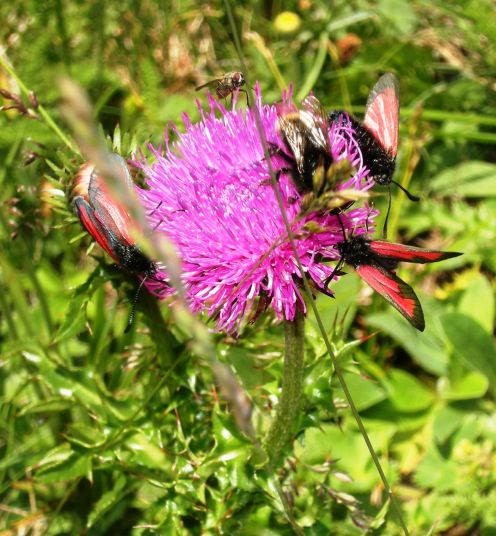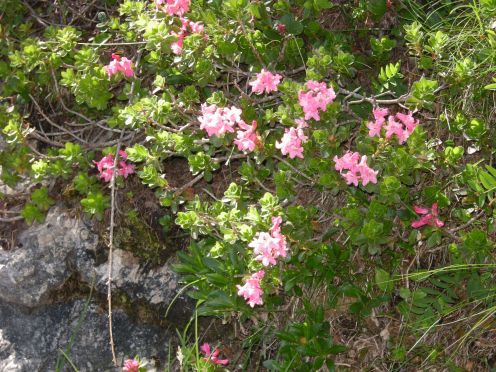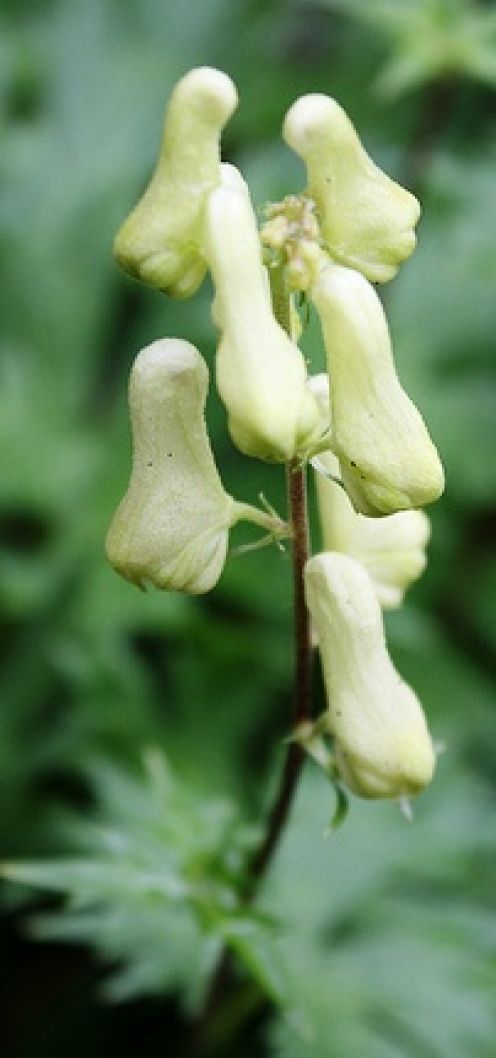There are many things you can love of Greece, many may be recalled with nostalgia, and many remain etched in
 memory for their enchanting beauty and uniqueness. One of these things is the natural vegetation that grows wild in many parts of Hellas, in those lonely, mysterious places in which hardly seems that the time has elapsed, and where modern men go so rarely.This is a small tribute to the beauty of the Greek flora, that I love so greatly!
memory for their enchanting beauty and uniqueness. One of these things is the natural vegetation that grows wild in many parts of Hellas, in those lonely, mysterious places in which hardly seems that the time has elapsed, and where modern men go so rarely.This is a small tribute to the beauty of the Greek flora, that I love so greatly!
Rosemary (Rosmarinus officinalis L.)
The rosemary is an evergreen shrub, a bush in the family of the Labiatae. The stem can be high by a few tens of cm up to two / three meters in height, the stem is initially prostrate at the base, where it occasionally produces many natural offshoots, then becomes gradually more and more erect and much branched. At the bottom, the trunk has a bark that browses in longitudinal strips, dark brown in colour. The leaves are leathery and persistent, have a linear form with the folded edge down, the upper surface is green and glossy, the lower one is white, because of unbranched and glandular hairs. The flowers are present for most of the year in the warmer parts of the Mediterranean coastline, they are of a beautiful color blue violet or lilac, and are grouped in cluster, have five petals, three upper and two lower. Look at the shape of each individual flower: does not looks like a little fairy with a sparkling and delicate dress?
As it only grows naturally along the coastline and forests that are located near the sea, never or almost never goes to the interior of a territory. Definitely it loves the sun and the heat, it fears only the cold and, above all, the prolonged frost, but aside from the cold, it is a rustic plant, highly resistant, which does not need particularly fertile or treated ground, does not need rain and is not subject almost to any illness or infection, to which are often subject all plants. Sometimes the growth is so luxuriant that comes to form dense and compact hedges, often covered with bees and butterflies, because they enjoy greatly its scent and its pollen.
The rosemary is a plant that, since ancient times, has inspired legends, traditions and miraculous medicines.
Its Latin name, “Rosmarinus”, relates it closely to the sea: according to some scholars it would derive from “ros” dew, “maris”, of the sea, with the meaning of “dew of the sea”. According to other scholars the name derives from “rosa”, rose, and” maris “, with the meaning of ” rose of the sea”. Still others claim it comes from “rhus”, shrub, and therefore it could mean “a shrub of the sea”. In any case, his pale blue color reminds of the color of the marine water of the Aegean sea.
In ancient Egypt was considered a symbol of immortality and ,because of this, they used to put a buch of it in the hands of the deceased. The Romans crowned with rosemary the idols of the Lares, the genii of the family home. His funeral use was maintained even in modern times, and even today, in Sicily, the funeral wreaths are woven with myrtle and rosemary. According to the doctrine which connects the plants to astral influences, and hence to the body parts, the rosemary is a plant of Gemini and rules on the hands and their woes. For this reason, in the ancient rites of purification, the manual ablutions with rosemary solutions were a prerequisite. This plant was considered so sacred that it could be used instead of incense in the religious ceremonies.
It is believed, in the folk tradition, that the rosemary is particularly dear to the fairies, often hidden in its flowers, sometimes taking the form of little snakes. Further, it is alleged that the poisonous animals nourish invincible aversion toward this plant and none of them would ever enter a house protected by the presence of the rosemary. It is a plant that gives joy and happiness, especially if planted near the house, and this is clear also by its Doric name, “makarìtes” , blessed. It is said that its scent removes the nightmares, carry away the smell that carry diseases and protects against lightning strikes (Corpus Hermeticum). In addition, its scent has the power to strengthen memory, so it was used to study near it or by holding a crown of it. Alludes to this property, in “Hamlet”, Ophelia, when she says: “That’s rosemary, that’s for remembrance …”
In the language of flowers, it means the happy heart, or the sincerity of love and marital fidelity, and, because of its beautiful meanings, is also considered an auspicious plant on the day of the wedding.
Apart from the legends, the rosemary is a plant with unique medicinal and cosmetic properties, and in this sense has always been used since remote antiquity. The part to be used in herbal medicine are the young twigs which must be carefully picked in early spring, and eventually dried in the shade (but with the drying up it loses most of its heady aroma). Many oils are obtained from the rosemary and many extracts useful in pharmacy, perfumery, and liquor. The plant has indeed stimulating and digestive properties, especially for the liver, has the ability to suppress the cough, thin the phlegm and accelerate the healing of illness. The essential oil is useful for the treatment of bruises, joint and muscle pains etc. In cosmetics, lotions and baths render fragrant and purify the skin, invigorate and strengthen, not to mention the lovely scent that can be enjoyed for long because it is very persistent and delicate.



Asphodel (Asphodelus albus)
The asphodel belongs to the lily family, is a herbaceous plant with a root system very complex, it consists of numerous swollen and tuberous roots, gathered together at the
apex. The stem is variously branched and can be high from 50 to 100 cm. All leaves arise from the base of the plant, have triangular cross section, and can be very short
to reach even 70 cm in length. The leaves become narrow gradually towards the top, are completely hairless and light green. The flowers have six petals fleshy, whites, and whose median rib is red or green to very dark. The fruit is a capsule oval and elongated, maturing, it opens in three perfect parts to release the seeds blackish brown. It is a plant that grows in grassy and open places in all the Mediterranean, provided that they are very sunny. It is very
frequently found in the so called “zone of the olive” and near the beaches. It much prefers the rocky soils or loose soils, such as limestone. This ornamental plant, of great charm and beauty, with grace appears in the meadows, both solo and in large floral carpets. is an apparition almost magical in the woods and sunny beaches along the Mediterranean, with its high stem and its ethereal bearing .
Ever since Homer, the asphodel has always been regarded as a plant of the Underworld, as Homer remembers in the Odyssey (Od. XI, 487 to 491 / 539-573). In the classical division of the Underworld, the house of Hades is divided into three sections: Tartarus is for the wicked and unjust, the Elysian Fields are for the just and virtuous, and finally the Asphodel Meadows are for those who, during their lifetime, were neither good nor evil but a mixture of both. Moreover, being necessary to the dead the food, the asphodel was planted on the graves and considered as their source of sustenance in the afterlife. Therefore, even in modern times, in the Mediterranean countries, a meadow covered with its flowers is always considered as a place to stay or visit of the dead. Theocritus links this flower to the Mystery religions and their
Gods, which often, in frescoes, are shown wearing crowns of white asphodel. The asphodel is also said to be part of the “Kepos”, the garden of the Gods, where they grow all the magical plants of the tradition. Pliny tells us that another name used to describe this flower so special, was “hastula regia”, the royal scepter, and therefore a manifestation of an higher divine power. Always Pliny relates that, in his days, it was sown before the door of country houses as a remedy against the negative sorcery.
The authors cite many ancient recipes to cook the root: Theophrastus says that the root bulb is the best part, that they used to eat with figs; Pliny notes that the bulb could be cooked in the ashes with the addition of salt and oil. It is said that Pythagoras was very fond of this type of food. Mallow and asphodel were considered to have been the first nourishment of mankind and so these flowers were offered on the altars (Plutarch, Moralia).
The ancient medicine, Greek in particular, suggests many therapeutic uses of this flower: the bulbs, cooked and used in the preparation of herbal teas were recommended as tonics, and pulped were useful for treating diseases of the joints and nerves, the seeds instead, taken into the wine, heal snake bites and scorpion stings.
The part used for herbal and medicinal uses is just the bulb, but it contains a certain amount of alkaloids, which makes the therapeutic use inadvisable for internal use.
The bulbs should be harvested when the plant enters the resting phase, in September / October, after the flower has dried, or in March, before it starts again the growth cycle. After being washed, you have to let them dry in the sun and always keep them away from moisture. The asphodel has a long traditional use for cosmetics applications as an emollient, cooling and decongestant for skin irritation, especially from the sun. An another traditional use is also that of the fresh pulp of the bulbs to remove the freckles.



Poppy (Papaver rhoeas L.)
The poppy belongs to the family of Papaveraceae, is an annual plant, very hardy and very easy to observe. The root is white, the top produces a rosette of leaves, from which rises then the stem, up to 80 cm long. The stem is covered with long silky hair, turned horizontally. The basal leaves form a dense rosette, they are lanceolate and have an elliptical form, the margin is toothed, the base narrows into a long stalk; on the contrary, the leaves of the stem are much simpler and smaller. All the leaves are covered with silky and soft hair. The flowers are solitary, one for each stem. Before flowering, the buds are hanging. The cup has two sepals that fall at the flowering, and the corolla has four petals rounded, wider than long, deep red, and often have a black or dark purple spot at the base. The stamens are very numerous, all black. The fruit, which contains many seeds blackish brown, is an oval capsule, maturing, it opens with small holes from which it drops its seeds.
The poppy grows naturally almost to the submontane belt, in grassy places shared with other species of flowers, and especially in the fields of wheat, but it is not uncommon, during periods of maximum flowering (May / July), to observe it on the edges of railways and country roads and grassland pastures on the hills. Sometimes it grows so dense to cover of bright red all the lawn, creating an incredible visual effect.
The Greeks represented Hypnos, the God of sleep, with his head crowned with this flower or we can see images of him, holding this flower in his hand. Likewise they depicted also Death and Night. Following this inspiration, the Baroque artists have adorned of the poppies the front of Oblivion of love, a winged boy asleep near the source of Cyzicus, where the water had the power to erase from the mind the remembrance of the past loves. All the species of poppy have similar effects, but not all contain substances of very high drug effects, like the papaver somniferum from which opium is extracted. The poppy is extremely common in Mediterranean regions during the late spring, its appearance indicates that the beginning of summer is near.
This flower is associated with the power, in particular the political power, because of the legend regarding the last king of Rome, Tarquin the Proud. Legend says that one day the king, wishing to show to his child the safest way to seize the city of Gabi, tore down, with a stick, the higher poppies in the garden, explaining with a symbolic action, that one had to remove, before all, the citizens most influential and powerful.
Because of its sedative and soporific virtues, the poppy is regarded as being under the influence of the planet Saturn and took the meanings of laziness and misanthropy, sleep and death. In nineteenth-century language of flowers is instead the symbol of the dormant pride.
In popular tradition, its petal was used as a test of loyalty in love affairs: place it on the palm of your hand and punch him, it must produce a snap to show that the beloved one is faithful.
The part with medicinal properties is the petal. They should be collected during the period of full bloom, the best time is late May and early June until the summer solstice and the petals should be detached with great delicacy. They must be dried in the shade and in shadows must always be preserved. The poppy is considered harmless because, in herbal medicine, are used the petals and not the capsules, but this does not exempt from a certain caution in the use of this flower at home. Infusions of poppy petals were reported as mild sedatives, acts to facilitate sleep, especially for the children and the elderly. To these infusions is attributed, since time immemorial, the ability to calm the cough and soothe the pains of stomach. The poppy should be used only when strictly necessary but, in the absence of precise knowledge, the capsules should never be used. The petals, because of their bright red color, were used in the past by women to make up the lips and cheeks. Extracts of the flowers have a calming and anti-inflammatory effect on the reddened skin. A beautiful and often a dangerous, wondrous flower!











 memory for their enchanting beauty and uniqueness. One of these things is the natural vegetation that grows wild in many parts of Hellas, in those lonely, mysterious places in which hardly seems that the time has elapsed, and where modern men go so rarely.This is a small tribute to the beauty of the Greek flora, that I love so greatly!
memory for their enchanting beauty and uniqueness. One of these things is the natural vegetation that grows wild in many parts of Hellas, in those lonely, mysterious places in which hardly seems that the time has elapsed, and where modern men go so rarely.This is a small tribute to the beauty of the Greek flora, that I love so greatly!







